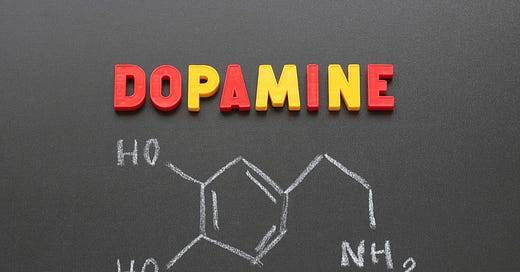Dopaminergic Rebound:
how it relates to switching antipsychotic medications + specific patient scenario highlighting it's relevance in clinical practice
DISCLAIMER
The content provided in this Substack post is for entertainment and informational purposes only and is not intended to serve as medical advice. The views and opinions expressed herein are those of the writer and should not be taken as definitive or authoritative. Readers should not rely solely on the information provided in this post to make decisions about patient care. Instead, use this content as a starting point for further research and consult a qualified healthcare professional before making any changes to treatment or medication regimens.
As working PMHNPs and student PMHNPs, it's essential to be aware of the potential complications that can arise when switching antipsychotic medications for patients with psychiatric disorders. In an earlier post we discussed cholinergic rebound. Today we will be discussing another potential complication: dopaminergic rebound. This phenomenon occurs when dopamine activity in the brain suddenly increases after a period of suppression. In this post, we'll discuss the key factors that contribute to dopaminergic rebound and explore the symptoms to watch out for when transitioning patients between antipsychotic medications.
Before we get into the meat and potatoes of the post, wanted to drop this link once more as it is a useful resource to help guide your treatment. Let’s go ahead and review the disclaimer as well:
DISCLAIMER
The content provided in this Substack post is for entertainment and informational purposes only and is not intended to serve as medical advice. The views and opinions expressed herein are those of the writer and should not be taken as definitive or authoritative. Readers should not rely solely on the information provided in this post to make decisions about patient care. Instead, use this content as a starting point for further research and consult a qualified healthcare professional before making any changes to treatment or medication regimens.
With that said, let’s dig into it:
What is Dopaminergic Rebound?

Antipsychotics primarily work by blocking dopamine receptors, particularly the D2 receptors, to control positive symptoms like hallucinations, delusions, and thought disorders. However, during the process of switching medications, differences in the drugs' pharmacological properties can lead to a temporary increase in dopamine activity.
Factors Contributing to Dopaminergic Rebound:
Discontinuation of the first antipsychotic: If the original antipsychotic drug has a shorter half-life than the new one, it may leave the system more quickly. As the first drug's effect wears off, previously blocked dopamine receptors become available again, leading to a sudden increase in dopamine activity.
Differences in binding affinity and potency: The new antipsychotic medication may have a different binding affinity or potency at the dopamine receptors, which can lead to a temporary imbalance in dopamine receptor activity.
Titration and overlap period: When switching antipsychotic medications, it's crucial to gradually reduce the dose of the first drug while slowly increasing the dose of the new drug. If the switch is done too rapidly or without an appropriate overlap period, it can lead to a sudden increase in dopamine activity.
Symptoms of Dopaminergic Rebound: Dopaminergic rebound can result in a temporary worsening of psychotic symptoms or the emergence of side effects. Key symptoms to watch out for include:
Exacerbation of psychotic symptoms: Patients may experience a temporary increase in hallucinations, delusions, or thought disorders due to the sudden increase in dopamine activity.
Motor disturbances: Dopaminergic rebound can lead to the emergence or worsening of extrapyramidal symptoms (EPS), such as dystonia, akathisia, and parkinsonism.
Agitation and restlessness: Patients may exhibit increased agitation, restlessness, or irritability as dopamine activity surges.
Manic symptoms: In some cases, dopaminergic rebound may induce or worsen manic symptoms like elevated mood, increased energy, impulsivity, and racing thoughts.
Conclusion: Understanding dopaminergic rebound is crucial for managing patients effectively during transitions between antipsychotic medications. By considering the pharmacological properties of the medications involved and establishing a titration plan that gradually adjusts the doses of both drugs, you can minimize the risk of dopaminergic rebound and ensure optimal patient outcomes.
Below is a patient scenario in which you can see a PMHNP correctly identify & manage the occurrence of dopaminergic rebound in a patient who required new antipsychotic medication.
Patient: John Doe Age: 35 Gender: Male Diagnosis: Schizophrenia
John has been on a stable dose of Risperidone (4 mg daily) for the past two years to manage his symptoms of schizophrenia. During a recent follow-up appointment, it was noted that John had been experiencing weight gain, had elevated prolactin levels, and also complained of sexual dysfunction. Given these side effects, his PMHNP decided to cross-taper his medication from Risperidone to Aripiprazole, which is known to have a lower risk of these particular side effects.
Cross-tapering schedule:
Week 1: Risperidone 3 mg/day, Aripiprazole 5 mg/day
Week 2: Risperidone 2 mg/day, Aripiprazole 10 mg/day
Week 3: Risperidone 1 mg/day, Aripiprazole 15 mg/day
Week 4: Risperidone 0 mg/day, Aripiprazole 20 mg/day (target dose)
On Day 10 of the cross-tapering process, John called his PMHNP’s office to report new symptoms. He was experiencing increased agitation, restlessness, and insomnia, as well as a resurgence of positive symptoms, such as auditory hallucinations and delusions of persecution. His family members confirmed that his behavior was increasingly erratic, and he seemed to be more paranoid than before the tapering process began.
The PMHNP considered the possibility that John was experiencing akathisia due to the initiation of Aripiprazole, as it is a known side effect of the medication. However, upon further evaluation, it was determined that the symptoms were more likely due to dopaminergic rebound for the following reasons:
The resurgence of positive symptoms: Akathisia is typically characterized by motor restlessness and agitation, but it is not commonly associated with the exacerbation of positive symptoms such as hallucinations and delusions. The return of these symptoms pointed more towards dopaminergic rebound.
Timing of symptom onset: John's symptoms began during the period of reducing Risperidone, which is a potent D2 receptor antagonist, while simultaneously increasing the Aripiprazole dose, which is a partial agonist at the same receptors. The timing of the symptoms corresponded more closely with the dopaminergic rebound hypothesis.
To address the dopaminergic rebound and minimize the risk of akathisia, the PMHNP adjusted the cross-tapering schedule and added an adjunct medication as described below:
Keep reading with a 7-day free trial
Subscribe to Short Bits for Inquisitive PMHNP's to keep reading this post and get 7 days of free access to the full post archives.





